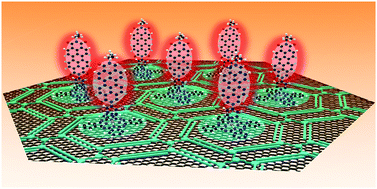2D host–guest supramolecular chemistry for an on-monolayer graphene emitting platform†
Abstract
Here is reported a novel strategy of non-covalent functionalization of graphene to avoid the electronic coupling between this semi-metal and directly adsorbed optically active molecules. Graphene-confined supramolecular host–guest recognition is used to elaborate an emitting hybrid platform. It is shown that the cavities of an on-monolayer graphene nanoporous self-assembled network are able to trap zinc phthalocyanine molecules coordinated to an emitting axial ligand. As a result, the emission of the hybrid system exhibits the same features as the isolated molecular emitter, demonstrating that the fluorescence is not quenched by graphene and that the well-controlled inter-chromophore distance prevents any interaction between the dyes. Furthermore, an in-depth modelling study confirms the weak interaction between the out of plane emitting moieties and the monolayer graphene. This work opens a new avenue for the realization of innovative light-responsive graphene-based devices in nanophotonics and optoelectronics.



 Please wait while we load your content...
Please wait while we load your content...